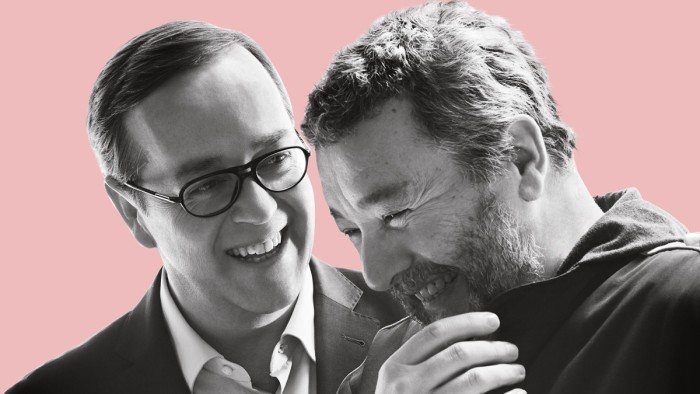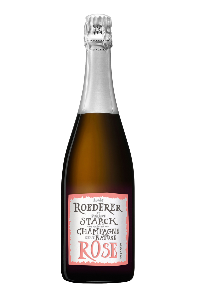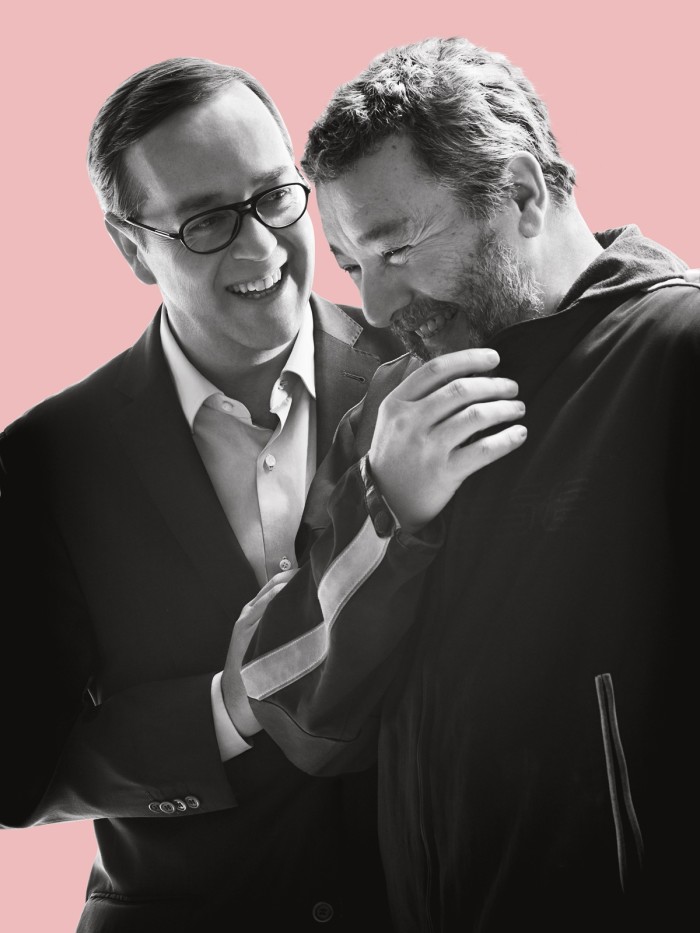Philippe Starck cracks open his new rosé champagne

Roula Khalaf, Editor of the FT, selects her favourite stories in this weekly newsletter.
I’m sitting in a gloomy chamber somewhere deep in the Royal Academy, on an even gloomier afternoon in October, when the French designer Philippe Starck makes his entrance.
“Hello, hello!” he singsongs, grasping my hand in a cloud of woody Fragonard by Fragonard.
We’re meeting to talk about the new cuvée he’s created with Louis Roederer Champagne, Brut Nature Rosé 2012. But first, Starck wants to size up the art. “So! Which of these is ze best?” he says, turning to assess the portraits on the walls. “Zis one? Zis one? No! Hmmm, not bad, not bad. Maybe zis one. Not zis one…” As he beetles around the room, I take in the outfit: black hoodie, black blazer and trainers, and rainbow neon trousers. His salt and pepper hair is cut short and chic. He looks good for 70.
“OK!” he says, coming over to the table and pulling up a chair. “What can we do?” He taps the table briskly, and there is a flash of red light. I look down and see it’s coming from a prosthetic digit he’s wearing on his index finger. Every time he taps the table, a red lightbulb inside it goes on and off. Flash. Flash.
“Ah yes!” he says, following my gaze. “We went to the toy shop for my daughter yesterday. I always like the light like that; it’s ahhhh, woooo! It is magic. I love everything to do with magic!”
He pulls a second toy finger out of his pocket, puts it on his other hand, jumps to his feet and tootles a fanfare: “Ladies and gentlemen, I shall now send the light!” With little cries of “Hup! Hup! Hup!” he appears to “throw” the light back and forth between his hands like a conjuror. “Oh! I have no co-ordination. I always miss!” he laments, pretending to drop the light on the floor.

Even if you don’t own an original Starck design, your home probably contains something – a chair, a glass – that bears his influence. Famous for injecting everyday objects with pared-back playfulness, Starck created many defining designs of the 1990s: the translucent Kartell Louis Ghost chair, the rocket-shaped Alessi lemon squeezer, the A-list Sanderson hotel, with its dreamlike white reception and galactic elevator.
Over the years, Starck has reimagined everything from travel passes and toothbrushes to the interior of Steve Jobs’s yacht. But it wasn’t until he was approached in 2006 by Frédéric Rouzaud, the CEO of Louis Roederer, that he considered doing a champagne.
“All these companies had come to me and asked me to design a bottle and I would always tell them: ‘I cannot design the bottle if I have not designed what’s inside.’ It has to be coherent,” he says. “But then one day Mr Rouzaud said, ‘Why not? OK, we do it.’ Which was incredibly courageous. I mean, this is one of the last family-owned champagnes. Elegant, super-rigorous and high-quality. It’s like they’re the Queen of England and suddenly there is this punk who arrives, me, and they say, ‘OK, come and dance with us.’”
Starck is a champagne aficionado (“I’ve been drinking it since I was six!”) – but he admits he knew nothing about making the stuff: “My idea was to give a new angle, a new view on champagne, to be a little bit more modern, to make the champagne speak a bit more about the idea of champagne, and less of the wine.”
Just to make life harder for everyone, Starck was also insistent that the cuvée should be brut nature – the driest, and most austere, style of all. It was an unforgiving brief, but fortunately for Starck he was working with Jean-Baptiste Lécaillon, a chef de cave with a preternatural ability to translate words into grape juice. “I would say to him: ‘What can be the taste of speed? What can be the taste of emptiness?’ And he would say, ‘The plot with this stone, or this orientation to the sun.’”

The result, which launched in 2014, was Louis Roederer Brut Nature 2006 – a biodynamic blend of Pinot Noir, Chardonnay and Pinot Meunier all harvested on the same day in the village of Cumières, and pressed as a single piece. Unblended, unsweetened and informed by one vintage, it showed Louis Roederer at its most avant-garde: taut, mineral and citrusy.
“I was so happy to make the champagne, I completely forgot to think about the label!” laughs Starck. “I said, ‘We have created a champagne that’s totally natural, totally honest. We should not start to add things on’.”
The label he eventually designed looks like a handwritten note. “I had this idea of a guy who makes champagne just for himself and his family, and he doesn’t have the money so he takes a bit of paper, and he writes it by hand and it’s not very well done, but he tries, and after he’s finished he says, ‘It’s a little sad, it’s not fun.’ So he takes a marker: ‘Allez! Some yellow, some pink like this. Oh, I am proud of that!’ I wanted the packaging to be very humble – trying to reach that absolute honesty.”
Only three vintages of Brut Nature have been released: 2006, 2009, and now 2012. Generally agreed to be an exceptional vintage, the 2012 is special because it marks the debut of the Brut Nature 2012 Rosé – a wine Starck describes as “minimalised, super-elegant, completely not like the rosé you drink on the beach or in the café without thinking about it”. Pale coppery pink, with delicate notes of spiced rose and pink grapefruit, it’s a vinous sleight-of-hand – full of aromatic colour and volume on the nose, but almost weightless on the palate.
“Some journalist once calculated that I have designed more than 10,000 things in my life, and for me that is a bit of a shame,” Starck says. “Because I am from the generation where, if you have an idea, you have to transform it into materiality – today, the dream has to become products. I don’t like that, I think that’s vulgar. So I always have to try to find a way to work on abstraction. That is why I chose to work on champagne – because when you work on champagne: with a drop of liquid you create a universe. It’s augmented life, augmented reality.”
Alice Lascelles is Fortnum & Mason Drinks Writer of the Year 2019. @alicelascelles.
Comments